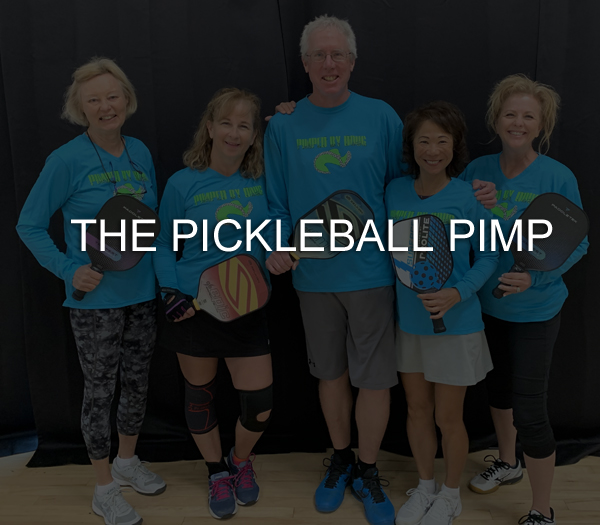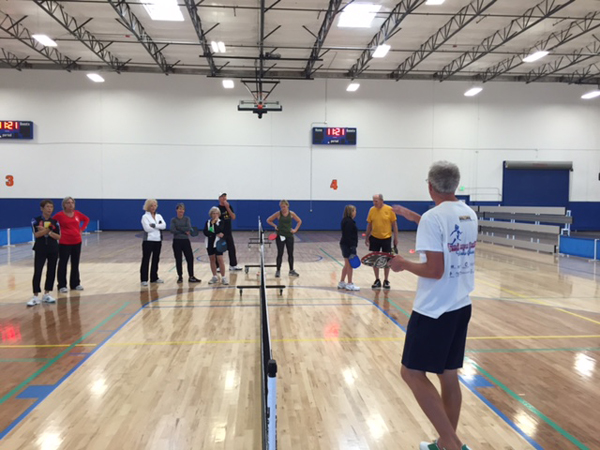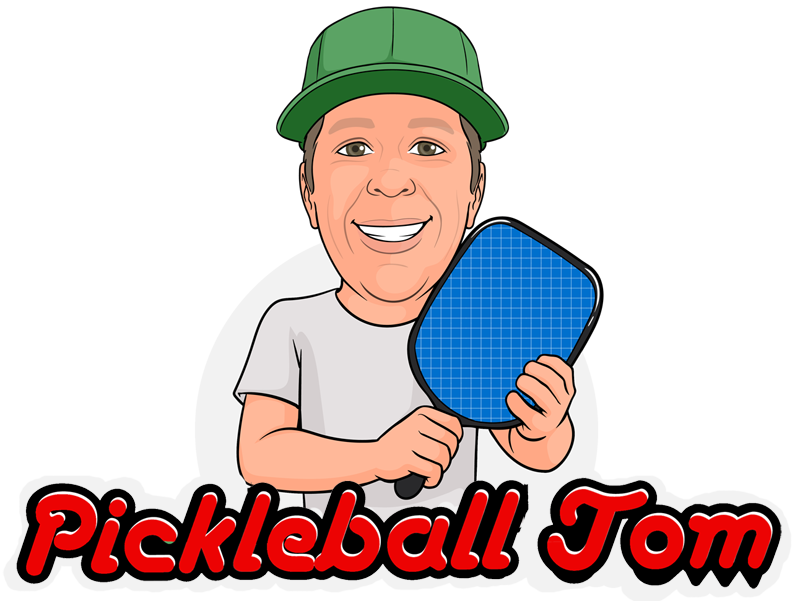The Pickleball Pimp

I recently met and have since taken some Pickleball lessons from a very accomplished local player named Doug Koch. He is a 5.0 player with quite a playing resume and from what I’ve seen a knack for imparting what he’s learned along the way to others. He goes by the nickname “The Pickleball Pimp” for his ability to put playing partners together. He gives individual and group lessons, puts on clinics and sells a little equipment all with the goal of financing his Pickleball addiction. I recently had a chat with him about a host of Pickleball subjects. I thought it may be interesting.
T) What is your Sports History and how did you get your Pickleball start?
D) I played all kinds of sports as a kid, ran track and cross country in high school. Played ping pong, tennis and squash recreationally during and after college. Was into running (10K’s half and full marathons) and mountain biking. I stayed pretty active. I got my Pickleball start in 2011 when my brother was at my house for my oldest daughter’s high school graduation. His in-laws live in Surprise Arizona so he had played there. He brought some paddles and a few balls with him, we stretched a badminton net between 2 garbage cans, used sidewalk chalk for the lines and played in my driveway. We ended up breaking the balls he brought and went to Big 5 and bought just about every kind of whiffle ball they had (no Pickleballs back then) to keep playing. We played all weekend and loved it, after he left I went looking for places and people to play with. I guess you could say I got hooked pretty quickly because before you knew it I was playing 4 to 5 times a week. I played my first tournament later that year with my brother and won a bronze medal at the 4.0 level. By the end of 2012 I had played in a few national events and had medaled often enough to move up to the 5.0 level.
T) Your tournament rating moved from a 4.0 to a 5.0 pretty quickly. From what I’ve seen people in tournaments tend to play at a level below their actual skill level (a 4.0 playing at a 3.5 or even 3.0) as defined by the USAPA’s player skill ratings guide. Can you speak to that?
D) When I started in Pickleball tournaments there was a player ratings committee that governed who played at what level. If a player had won or placed high often enough they were moved up to the next level going forward. My philosophy on ratings is if you are as skilled as 25% of the people in the next level it’s probably time to move up. Doing so challenges you to improve. Currently I see some people that are reluctant to move up even if they often dominate their current level so yes I think there is a bit of that going on. The USAPA now has a rating system in place that over time should level the playing field for all players.
T) Teaching is now a large part of your Pickleball life, how did you find yourself gravitating in that direction?
D) I have 2 daughters so as they grew up I coached them and their friends in soccer, basketball and track. After I got my masters degree I did some teaching for a while before I got into my career as a computer programer. As I started having some Pickleball success I had people come to me and ask if I would work with them to help them improve. Since I had some past experience in both coaching and teaching it turned out to be a very good fit. As I did more Pickleball coaching I did less computer programing and eventually I stopped coding all together.
T) When you start teaching someone at the beginner level what types of things do you focus on to help them get a good foundation to build on?
D) With a beginner I try to start with the basics of grip, movement, balance and next shot readiness. Teach them the serve fundamentals, the importance of getting a high percentage of serves and returns in and when possible deep in the court. I try to teach them good shot consistency and the importance of getting into the net as early in the point as possible. With beginners once they have the basics we really focus on consistency and keeping the ball in play to let your opponent make the mistake. Later we will get into anticipating where your opponent might try to attack you and where you want to attack them.
T) Same question about what you focus on teaching someone at the intermediate level?
D) At the intermediate level I try to refine their consistency even more. Teach them to not try to hit it too close to the lines or the net to improve the percentages of balls in play. Intermediates tend to try to hit the ball too hard when a softer shot with good placement would work just as well but with a higher conversion rate. Try to get them to recognize the value of hitting a softer shot into the kitchen to allow yourself and your partner the opportunity to establish position at the no volley line. Positioning at the no volley line is so important it can’t really be overstated, usually if one team has that position and the other one is at the baseline or stuck in no man’s land the team at the no volley line will win the vast majority of the points. Learning to hit balls that are hard to attack (balls that drop into the kitchen and require to be hit from below the top of the net) is an essential tool to move someone from intermediate to advanced.
T) Same question about what someone needs to move up to an advanced level?
D) At the advanced level most people have pretty much all the shots and are pretty good at being in the right place on the court most of the time. I try to focus on teamwork and trying to set your partner up for a high percentage shot whenever possible. Shot placement gets even more critical when you are playing against someone at a higher level so we work on that quite a bit. How to recognize what shots are attackable and how to attack them. The best way to put a ball away when you get the opportunity. I try to get them to recognize their opponents weaknesses and strengths and to try to stay away from the strengths and exploit the weaknesses whenever possible. Figure out what your opponent is ready for and hit something else if you can. For example if they are crowding the middle try to hit it down the line to get them reaching and off balance.
T) In general what fundamentals do you stress to all levels and why?
D) We have talked about on court positioning and that is always going to be important but along with that personal positioning is huge also, maybe even more so. What I mean by that is always be ready to hit a shot. Be on the balls of your feet, well balanced and with the paddle in the ready position out in front of your body. If you have just hit a shot that took you off balance or took your paddle out of the ready position get back to “ready” as soon as possible! Get in the habit of moving your feet to hit a shot instead of reaching for the ball. Your conversion rate will increase dramatically when you are centered over your feet with the paddle out in front. Learn to hit the ball when it is out in front of you rather than letting it get into your body of past you is also a very important skill for all levels. It is much easier to direct the ball where you want it to go if you hit it early rather than late.
T) You use Selkirk equipment, are you sponsored by them or is it your paddle of choice?
D) Both. They were a relatively new company. They gave me a few paddles to try at the 2015 nationals, I really liked them so they asked me to join team Selkirk. We signed an agreement and I have been playing their equipment ever since. They are a great company, in fact I recently received and started playing with their new Vanguard Carbon Fiber paddle which has a huge sweet spot & allows me to get more spin on my shots. They are very innovative and forward thinking. They are always trying to improve their equipment, I am very happy with the products they produce.
T) What is a good practice/play ratio for the average player?
D) A lot of the professionals practice 80% of the time. That isn’t something most recreational players will do. I tell people to warm up for 10 to 15 minutes before they play. Hit all the shots dinks, drives, drops, serves and volleys. Maybe play a little skinny singles but practice with a purpose not just to limber up before start the games. If you have someone willing to practice longer with you and you have the place to do it more is better.
The above is just an example of Doug’s thoughts on playing, teaching and living Pickleball. There was so much more as we spoke for over an hour. My recommendation would be if you live in the Sacramento area of northern California look Doug up @ pickleballpimp.com and schedule some sort of instruction either individual or group, you won’t regret it. For people living in other areas ask around and get some recommendations about local teachers and take a lesson, a little instruction can go a long way to help you get better and enjoy Pickleball even more!
Play well, maybe I’ll see you on a court someday.



